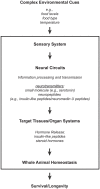Neuronal inputs and outputs of aging and longevity
- PMID: 23653632
- PMCID: PMC3644678
- DOI: 10.3389/fgene.2013.00071
Neuronal inputs and outputs of aging and longevity
Abstract
An animal's survival strongly depends on its ability to maintain homeostasis in response to the changing quality of its external and internal environment. This is achieved through intracellular and intercellular communication within and among different tissues. One of the organ systems that plays a major role in this communication and the maintenance of homeostasis is the nervous system. Here we highlight different aspects of the neuronal inputs and outputs of pathways that affect aging and longevity. Accordingly, we discuss how sensory inputs influence homeostasis and lifespan through the modulation of different types of neuronal signals, which reflects the complexity of the environmental cues that affect physiology. We also describe feedback, compensatory, and feed-forward mechanisms in these longevity-modulating pathways that are necessary for homeostasis. Finally, we consider the temporal requirements for these neuronal processes and the potential role of natural genetic variation in shaping the neurobiology of aging.
Keywords: aging; brain; homeostasis; longevity; nervous system; neuroendocrine system.
Figures




References
-
- Alcedo J., Maier W., Ch’ng Q. (2010). “Sensory influence on homeostasis and lifespan: molecules and circuits,” in Protein Metabolism and Homeostasis in Aging, ed. Tavernarakis N. (Austin, TX: Landes Bioscience; ), 197–210 - PubMed
LinkOut - more resources
Full Text Sources
Other Literature Sources

